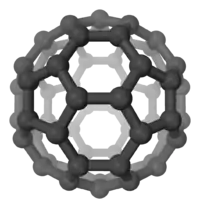Carbon monosulfide
Carbon monosulfide is a chemical compound with the formula CS. This diatomic molecule is the sulfur analogue of carbon monoxide, and is unstable as a solid or a liquid, but it has been observed as a gas both in the laboratory and in the interstellar medium.[1] The molecule resembles carbon monoxide with a triple bond between carbon and sulfur. The molecule is not intrinsically unstable, but it tends to polymerize. This tendency reflects the greater stability of C–S single bonds.
| |||
| Names | |||
|---|---|---|---|
| IUPAC name
carbon monosulfide | |||
| Other names
carbon(II) sulfide, thiocarbonyl, sulfidocarbon, methanidylidynesulfanium | |||
| Identifiers | |||
3D model (JSmol) |
|||
| 1697516, 1918616 | |||
| ChEBI | |||
| ChemSpider | |||
| 648 | |||
PubChem CID |
|||
CompTox Dashboard (EPA) |
|||
| |||
| |||
| Properties | |||
| CS | |||
| Molar mass | 44.07 g·mol−1 | ||
| Appearance | reddish crystalline powder | ||
| insoluble | |||
Except where otherwise noted, data are given for materials in their standard state (at 25 °C [77 °F], 100 kPa). | |||
| Infobox references | |||
Polymers with the formula (CS)n have been reported.[2] Also, CS has been observed as a ligand in some transition metal complexes.
References
- Wilson, R. W.; Penzias, A. A.; Wannier, P. G.; Linke, R. A. (1976). "Isotopic abundances in interstellar carbon monosulfide". Astrophysical Journal. 204 (pt 2): L135–L137. Bibcode:1976ApJ...204L.135W. doi:10.1086/182072.
- Chou, J.-H.; Rauchfuss, T. B. (1997). "Solvatothermal Routes to Poly(Carbon Monosulfide)s Using Kinetically Stabilized Precursors" (PDF). Journal of the American Chemical Society. 119 (19): 4537–4538. doi:10.1021/ja970042w.
This article is issued from Wikipedia. The text is licensed under Creative Commons - Attribution - Sharealike. Additional terms may apply for the media files.


